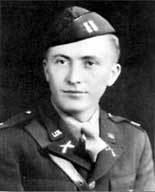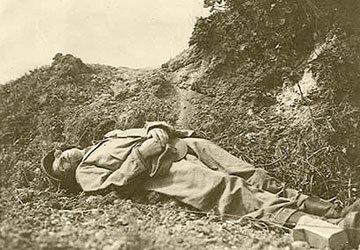Nickname(s) "Snort" Name Henry Waskow Service number O-407112 | Years of service 1939–1943 | |
 | ||
Buried at Sicily-Rome American Cemetery and Memorial (41°27′55.08″N 12°39′30.18″E / 41.4653000°N 12.6583833°E / 41.4653000; 12.6583833 (Sicily-Rome American Cemetery and Memorial)) Place of burial Sicily–Rome American Cemetery and Memorial, Nettuno, Italy | ||
Allegiance United States of America | ||
Captain Henry Thomas Waskow (September 24, 1918 – December 14, 1943) was a United States Army officer, with the rank of captain, memorialized in Ernie Pyle's dispatch "The Death of Captain Waskow," which in turn was faithfully portrayed in the movie The Story of G.I. Joe. The column also publicized the documentary film The Battle of San Pietro, by John Huston, depicting the action in which Waskow died.
Contents

Ernie Pyle wrote of Captain Waskow:

In this war I have known a lot of officers who were loved and respected by the soldiers under them. But never have I crossed the trail of any man as beloved as Capt. Henry T. Waskow of Belton, Texas.[Full text of the column at link.]

Childhood and adolescence

Waskow was born in DeWitt County, Texas, the seventh of eight children, by children of German immigrants. His parents were cotton farmers, and moved around in various places in Texas until settling in Belton, Texas, when Henry was two years old. He attended the public schools and graduated from Belton High School in 1935, as president of the student council, receiving top grades and showing a particular aptitude for mathematics.
College and early military career
He attended Temple Junior College on a scholarship, often commuting by foot from his parents' home, and taking on custodial duties on campus. During his college years, he enlisted in the Texas Army National Guard, in the 143rd Infantry Regiment, part of the 36th Infantry Division with his two older brothers, John Otto Waskow, and August Waskow.
Following his two years in junior college, Waskow was offered a position as a teacher but turned it down to attend Trinity University, which was then in Waxahachie, Texas. He graduated with a bachelor's degree on June 5, 1939, and was offered a job at Belton High School. He turned it down, expecting to be called for full-time military duty.
World War II
When President Franklin D. Roosevelt put the National Guard under federal control and activated the 36th Infantry Division, the Waskow brothers were transferred to Camp Bowie, Texas in January 1941. Waskow was given his commission as a second lieutenant on March 14, 1941 and received training at Fort Benning, Georgia before being assigned to 'B' Company of the 1st Battalion, 143rd Infantry Regiment.
As an officer, Waskow proved to be a principled and compassionate leader, giving those under his command individual attention. He attended various training programs throughout the country before rejoining his unit at Camp Edwards in Falmouth, Massachusetts. While there, he was promoted to captain.
In early April 1943, sixteen months after the Japanese attack on Pearl Harbor, on December 7, 1941 and the subsequent German declaration of war on the United States, four days later, which brought the United States into World War II, the 36th Division, commanded by Major General Fred L. Walker, a distinguished World War I veteran, was shipped from New York Harbor to Oran, Algeria, and was then stationed in Rabat in Morocco. The division, originally slated to participate in Operation Husky, the Allied invasion of Sicily, although in the event never used, was kept in reserve until September 9, when it landed on Red Beach near the ancient city of Paestum in the Campania region of Italy as part of Operation Avalanche, the Allied invasion of Italy. The 36th Division was part of the U.S. Fifth Army. Waskow saw combat for the first time in the struggle to hold and enlarge the Salerno beachhead and for the Chiunzi Pass, where he commanded Company 'B'. His brother August was wounded during the battle and sent home. The 36th Division sustained very heavy casualties in the battle, and was held in Fifth Army reserve for the next few weeks, absorbing replacements and training for future combat operations.
Returning to combat in mid-November, Captain Waskow and his men fought their way north past Naples, relieving the 3rd Infantry Division near Mignano and then marched on, largely on mountain trails to Monte Sambucaro (Hill 1205), near San Pietro Infine. The battle for San Pietro was one of the worst of the Italian Campaign. After a week, Waskow's company had been reduced to the size of a platoon, but participated in the assaults. On the evening of December 12, on his way up from the treeline to launch an attack on a ridge known as Hill 730 (41.470°N 13.959°E / 41.470; 13.959 (Hill 730)), his unit was attacked, and a shell hit near him and his men. Fragmentation caught him in the chest and killed him almost immediately.
Ernie Pyle
Riley Tidwell, who had been Waskow's assistant throughout the war, left Waskow's body where he had died and went down from the mountain to notify Waskow's superiors that he had been killed. On the way, he encountered Ernie Pyle, the noted war reporter.
Pyle waited the three days it took to recover Waskow's body. It was when the body was unloaded from the back of the mule in the middle of the night along with several other casualties, and his men made their emotional farewells with their commander, that Pyle was inspired to write the dispatch that memorialized Waskow. Pyle published his column on January 10, and stacks of letters started arriving to Waskow's survivors in Belton afterwards. His sister released a photograph of Waskow taken while he was a lieutenant, after adding another bar to reflect his captain's rank when he died.
Following his wishes, Waskow was buried in Italy. His grave is at the Sicily-Rome American Cemetery in Nettuno. His grave is on Plot G Row 6 Grave 33.
A memorial was held for him in his home town when his mother died a few months later, and he was posthumously awarded the Legion of Merit. He was also awarded the Purple Heart.
Legacy
Pyle wrote the column about Waskow a few days after his death, in Caserta, where he had become depressed and was drinking heavily. He asked AP correspondent Don Whitehead to read the columns, exclaiming, "I’ve lost the touch. This stuff stinks. I just can’t seem to get going again." Whitehead recognized its tremendous value and urged its publication. It was first published a month later, after notification of the next of kin, in Scripps-Howard's home newspaper, the Washington Daily News, which gave it front page billing, and sold out its entire edition. The entire column was read on the radio by Raymond Gram Swing and Arthur Godfrey. It was reprinted in Time magazine, and was used for a war bond drive.
In his last will and testament, Waskow wrote:
Pyle's story informed John Huston's documentary The Battle of San Pietro (released in 1945) and heightened interest in it. The character of Captain Bill Walker (played by Robert Mitchum) in William Wellman's motion picture The Story of G.I. Joe is partly based on Pyle's column about Waskow's death. The US Army insisted on changing the surname of Waskow to Walker in the film's screenplay
Henry T. Waskow High School (Belton New Tech @Waskow) in Belton and VFW Post 4008 are named after Waskow.
